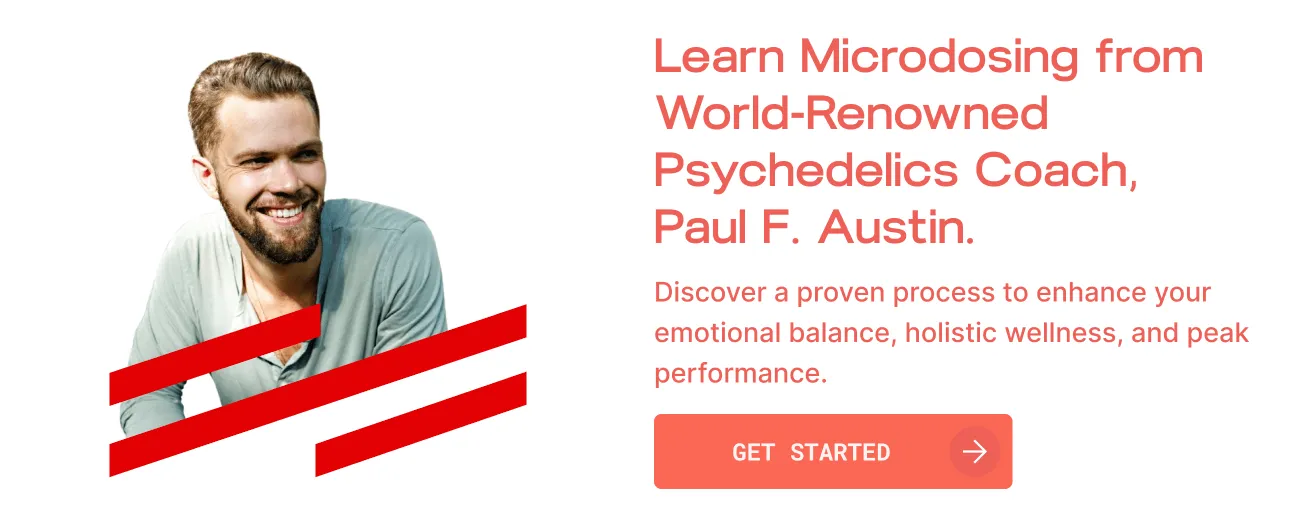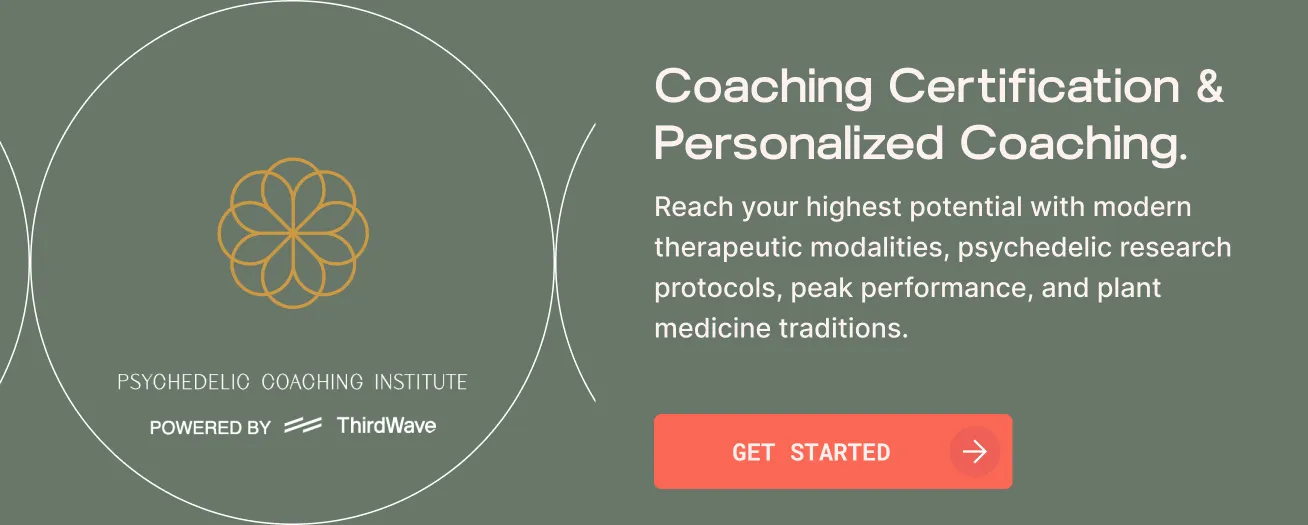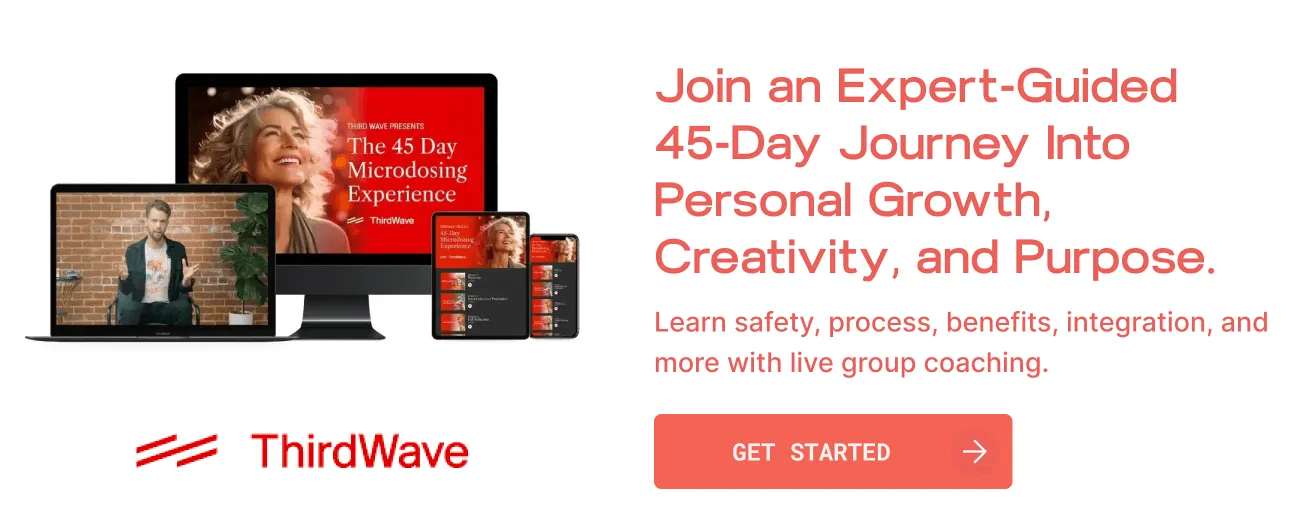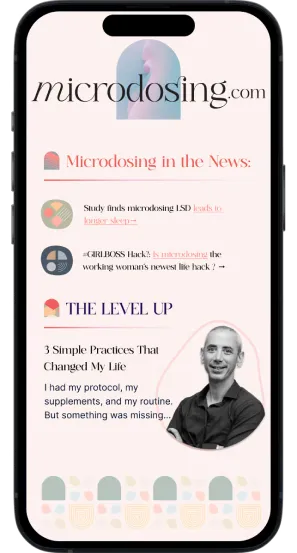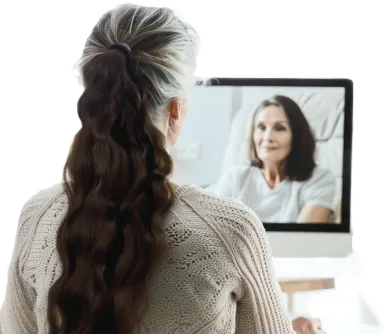The surge in curiosity about microdosing is undeniable: since 2015, Google searches for the term “microdosing” have jumped by 1,250%,(1) underscoring a significant cultural interest in exploring this unconventional practice.
Like any complementary and integrative therapy,(2) microdosing should be approached with care and under the guidance of a trusted expert and evidence-informed guidelines. Psychedelic experiences, whether on a macro or micro level, are subjective and unique. These powerful substances interact with each person’s biology, psychology, and neurological predispositions.
Despite microdosing’s rapid cultural acceptance, the slower pace of scientific research leaves all microdosers exposed to unrecognized and unknown risks. As this trend grows, it is vital for the movement that everyone takes the initiative to thoughtfully learn about microdosing psychedelics and current best practices for harm reduction.
Microdosing.com highly recommends first-time microdosers seek guidance from a trusted expert or medically informed coach in coordination with mainstream medical care and adherence to evidence-based protocols that prioritize safety.
Fortunately, with the rise in mainstream interest, psychedelic-informed experts are leading educational courses and offering 1-on-1 coaching designed to help new microdosers navigate the inherent risks and potential benefits of this practice.
This article will break down the basics of microdosing, introduce resources for further education (including our top picks for coaching and courses), and list the most important details when considering your first (or next) step.
If you are here because you googled “how to microdose mushrooms,” “how to microdose shrooms,” or even “magic mushrooms microdosing,” you can learn about microdosing magic mushrooms in our full-length article – How To Microdose Magic Mushrooms & Psilocybin.
Just want to get started microdosing now? Click here to access the leading experts in personalized microdosing protocols, with more than 5,000 customers worldwide.What is Microdosing?
A microdose is a very small dose of a psychedelic substance.
Many informal reports suggest microdosing has the potential for long-term health and wellness benefits without causing participants to get“high.” (3) Microdosing may be a way to experience the potential benefits of psychedelics without the intensity of a full psychedelic trip.
In a podcast hosted by Tim Ferriss, Ayelet Waldman, an investigative essayist and author of A Really Good Day: How Microdosing Made a Mega Difference in My Mood, My Marriage, and My Life (focused on LSD), shared that…
“Microdosing is the practice of taking a sub-perceptual dose of a psychedelic drug. You can microdose anything, but in this case, we’re talking about psychedelics. When I say sub-perceptual, I mean you do not trip, you do not have a hallucinatory experience. You see no kaleidoscope of colors. The idea is to take a dose that you cannot perceive of any effects, but that there is something going on metabolically.”(4)
Proper evidence-informed microdosing involves regular dosing with adherence to standardized protocols (most of which are experimental at this point) and generally takes place over an extended duration, measured in weeks or months.
Many people choose to microdose in hopes of enhancing their creativity, cognitive function, and emotional well-being. (5) The dosage for microdosing is typically 5 to 10% of a recreational dose, depending on the substance, such as psilocybin (magic mushrooms) or LSD.
Microdosing Versus Macrodosing
While microdosing and macrodosing are at opposite ends of the psychedelic experience spectrum, they depend on the same substance, distinguished only by the size of the dose.
Following Albert Hofmann’s renowned “Bicycle Day” in 1943, research into psychedelics has gone through various eras, with studies and clinical trials revealing many therapeutic benefits linked to macrodosing psychedelics.
On the large dose end of the spectrum, macrodosing aligns with the traditional concept of a psychedelic “trip” or “journey.” This experience can be hard to conceal as it alters one’s sense of self-perception. Users may experience intense emotions, hallucinations, time distortion, ego death, and either profound introspection or disorientation. (6)
On the other end of the spectrum, microdosing psilocybin mushrooms and other psychedelics entails regularly ingesting tiny amounts of these substances. This approach generally allows individuals to maintain their daily routines without significant cognitive disruption or challenging experiences. (7)
While microdosing is not entirely free from risk, there are published reviews from experts in the field that generally agree that a thoughtfully designed protocol with substances of known potency, free from contamination, has a low probability of producing an unwelcome experience or harm during shorter-term use. (8)
For those who are interested but cautious (a smart way to approach psychedelics), microdosing with professional guidance may allow users to explore the personal effects of psychedelics with a reduced risk profile.
Why Microdosing Has Become So Popular
Psychedelics and microdosing are making headlines and gaining bipartisan political support (9), becoming more popular than ever across all demographics in America. This is especially true among Gen Z, who are more likely to attend therapy than any other age group (10) and often prefer cannabis and psychedelic substances over alcohol. (11)
This surge in popularity is likely driven by the belief that psychedelics can meet the unmet needs of diverse groups such as veterans, parents, mental health advocates, celebrities, academic researchers, business leaders, athletes, and addicts – all searching for innovative solutions to persistent challenges.
A common thread among these groups is the hope that upcoming clinical research will confirm the mental health benefits now reported subjectively by countless microdosers on Reddit, YouTube, and Instagram. Strong clinical evidence is particularly significant given that 1 in 5 adults in the US deals with mental illness,(12) many of whom are considered to have treatment-resistant depression. (13)
For leaders of these diverse groups, microdosing presents a compelling option to introduce their communities to the benefits of psychedelics while avoiding the intense experiences associated with larger doses.
Beyond the voices on the internet, mainstream media is also amplifying the conversation with regular editorials in major outlets such as The New York Times, NPR, The Wall Street Journal, and Rolling Stone Magazine.
Also, many business leaders, athletes, entertainers, and celebrities now feel comfortable endorsing the use of psychedelics and microdosing on their social media channels. Prominent figures such as Tim Ferris, Sergey Brin, Chelsea Handler, and Kasey Musgraves have been vocal about their experiences and practices in popular media—causing their fans and followers to consider psychedelics and microdosing—some for the very first time.
What Does The Science Say?
While abundant personal reports on social media platforms detail the experiences of those microdosing shrooms and other psychedelics, clinical research is severely lacking. (14)
This gap is largely due to funding challenges, the legal status of psychedelics, and the difficulties in conducting blinded trials. (15) Consequently, many potential mental health benefits and other uses remain undocumented and undiscovered. Conversely, potential adverse side effects might also be underreported.
Encouragingly, more research is underway, including an up-and-coming study by Yale School of Medicine, specifically focusing on microdosing psilocybin. (16)
Early research and countless personal reports (17) suggest microdosing can yield meaningful outcomes, such as improved mental clarity, enhanced creativity, stabilized emotional well-being, and reduced symptoms of mental illnesses.(18)(19)
A 2019 study published in the PLOS One journal reported that adults who microdosed various psychedelic substances noted significant reductions in anxiety and depression symptoms. (20) Additionally, some evidence indicates that microdosing may serve as a form of harm reduction for treating active addiction. (21) It has also shown promise in alleviating migraines and PTSD symptoms. (22)
Why People Are Turning to Microdosing Courses and Expert Guidance
While microdosing may have benefits for some, it can be risky to implement a new supplement protocol without an understanding of how it will interact with your current medications, supplements, health conditions, and lifestyle. Until regulation matures and public psychedelic education becomes mainstream, misinformation and sensationalism around microdosing will continue, resulting in misguided microdosers.
By engaging in a comprehensive microdosing course, users can equip themselves with the knowledge and support needed to navigate this practice more safely and effectively. These courses typically cover the history and science of psychedelics, offer dosing guidelines, and help track personal goals. Top courses also provide access to a community for knowledge sharing, Q&A, and support.
Many think that intentionality in microdosing is essential for obtaining maximum benefit.(23) Reflect on why you are microdosing, your goals, and the changes you want to see. Programs with expert guidance will assist you in defining your intentions.
Additionally, top-tier courses address contraindications, highlight who should avoid psychedelics due to medical or psychiatric conditions, and offer best practices for harm reduction.
At Microdosing.com, we believe that quality microdosing education courses are worth the expense so long as they are evidence-guided.
How to Find the Best Microdosing Courses and Instructors
Finding a comprehensive and credible microdosing course created by a legitimate expert can be challenging. To get the most out of your experience, It’s crucial to know what to look for. Here are some general guidelines to help you navigate:
Evaluate credentials
Carefully evaluate each instructor and course. What qualifications do they hold? Where did they receive their training and education? Investigate the various accreditations since not all certifications are created equally. Make sure instructors have a good reputation.
Some well-regarded certification programs are The California Institute of Integral Studies, The Integrative Psychiatry Institute, Fluence, and The Psychedelic Coaching Institute.
Discuss Psychedelic Substances
Certain microdosing programs are dedicated to one specific substance, such as psilocybin or LSD, whereas others explore a wide array of psychedelics. Ensure the course you choose aligns with your interests.
Trust The Science
When it comes to microdosing and psychedelic therapy, it’s crucial to rely on the available scientific evidence. Ensure that any program or instructor you choose is science-based and backed by significant experience. Since the psychedelic space is not yet fully regulated, the quality of programs can vary greatly, and not all are research-informed. Make sure your program or instructor focuses on the protocol, the science, and you, not themselves or their proprietary processes.
Research And Compare Programs
To make an informed decision when choosing a microdosing program, it’s important to compare their course offerings. Consider factors like price points, learning modules, community support, and instructor backgrounds.
What To Know Before You Dose
It’s important to lay a solid foundation before you begin microdosing. Professional and medically informed psychedelic coaching and courses deliver comprehensive education in all the areas listed below.
Safety
Always consult with a healthcare professional before starting any course of psychedelic therapy or microdosing regimen.
While microdosing in the short term is generally considered low risk, psychedelics can have serious consequences if misused or individuals are unusually sensitive to their effects. (20)(24) Every experience is subjective, and some individuals may not be good candidates for microdosing.
You should avoid psychedelics and microdosing if: you are pregnant or nursing or if you or your family members have a history of seizure disorder, cardiovascular disease, arrhythmias, or history of stroke, or are on certain psychiatric medications that can interact. (25) It’s important to know your personal and family mental health history because there is a small percentage of people with specific mental health issues, including those with personal or family history of psychosis, mania, or suicidality, who should avoid psychedelics entirely.
Protocols
Expert guidance should always emphasize following an evidence-based protocol. These protocols typically specify how often to microdose, the appropriate dosage, and the timing.
Many protocols are still being investigated and studied, so they are still evolving and not universally agreed upon by the scientific community.
Set and Setting
Research suggests that set and setting significantly impact the effectiveness of microdosing. (26)
“Set” refers to the mind and mental state that a person is in when taking the substance.
“Setting” refers to the physical and social surroundings of the individual.
The influence of these factors varies between individuals but should be considered to maximize the benefits of the experience. (26)
Preparation and Integration
Microdosing involves more than just taking the substance; preparation and integration are arguably the most critical components of a successful protocol. Preparation involves getting ready before you begin microdosing, and integration is about introducing your insights and nurturing new behaviors afterward.
These two steps are the key to realizing the full benefits of microdosing, and it is recommended to emphasize them for optimal growth. (27)
Substances
While psilocybin mushrooms are commonly associated with microdosing, people also microdose other substances. It’s crucial to thoroughly research which substances might best support your therapeutic goals before starting a microdosing regimen.
Note that the potency of mushrooms and other psychedelics can vary widely between strains, species, and suppliers. Substances accompanied by a certificate of analysis from a harm reduction laboratory, confirming their purity and potency, are always preferable and represent best practices.
To give you an idea of what a microdose consists of for different substances, here are some examples:
- Microdose Psilocybin Mushrooms
Magic mushrooms, or psilocybin mushrooms, come in many species and varieties. A psilocybin microdose may improve mood, reduce anxiety, increase creativity, and enhance cognitive function. (5) A typical microdose is between 0.1 – 0.3 grams of dried mushrooms. (8)
Although microdosing is popular, it’s recommended to learn about microdosing mushrooms in detail, preferably from a medically-informed coach or course, before starting.
Note that there are concerns about cardiovascular risks, such as cardiac fibrosis, with long-term use of psilocybin, though this hasn’t been well studied in microdosing specifically as of now. (29) For more information, refer to our guide on How To Microdose Magic Mushrooms & Psilocybin. - Microdose LSD/Acid
LSD (lysergic acid diethylamide), or acid, is an incredibly powerful hallucinogenic and psychedelic substance.
It may have first been Albert Hoffman who pondered on how to microdose acid, as Hoffman was the scientist who famously first synthesized it and is reported to have taken “small amounts” later in life. (30)
A study published in 2019 looked at the safety and tolerability of microdosing LSD for Alzheimer’s disease and found it was well tolerated and encouraged more research in this area. (31)
A 2020 experimental study in the Journal of Psychopharmacology looking at the effects of LSD on pain found that microdosing LSD significantly increased pain tolerance and reduced pain perception in participants. (32) These effects, similar to opioids like oxycodone and morphine, lasted at least five hours without causing significant psychedelic effects. The researchers concluded that given the current known challenges and risks of opioid pain medications, microdosing LSD for pain shows promise as a potential alternative, with potentially fewer side effects. Yet more research is needed.
While there are varied approaches for how to microdose LSD, evidence-based protocols suggest a common range of 5-20 μg (micrograms), with an average dose of about 10 μg, equivalent to 1/100th of a milligram. (20)
Note that there is a concern for cardiovascular risks with the regular use of LSD, yet it has not been well studied at this time for microdosing. (29)
At microdosing.com we have found that a 10 microgram dose can potentially produce an experience of going beyond sub-perceptual effects. We advise starting with a dose of 5 micrograms, and adjusting as needed. - Microdose MDMA
MDMA (methylenedioxymethamphetamine) is a synthetic drug that produces euphoric feelings, reduces fear, and increases openness and prosocial behaviors. MDMA is being studied, at higher doses, to reduce PTSD symptoms and anxiety in patients. (33) Although there is a concern for cardiovascular risks, this has not been well studied at this time for microdosing. (29) - Microdose ketamine
Ketamine, a sedative and powerful dissociative, has been studied for use with therapy to treat PTSD, addiction, and depression. (34) While there is evolving research on low-dose ketamine, it is still in the early stages. (35) Although microdosing ketamine for anxiety and depression has not been well-studied, macrodoses for treatment-resistant depression are now commonly practiced in many clinical settings. (28) There is some growing evidence of the use of low or microdosed ketamine in palliative and end-of-life care for pain and psychological symptoms. (36)
Note that there are known risks to repeated high-dose ketamine use, specifically an increased risk of ketamine-induced cystitis (37) yet this hasn’t been well studied for microdosing at this time. - Microdose DMT
DMT (dimethyltryptamine) is a very powerful psychedelic. It occurs naturally as tryptamine in many plants and animals, including humans. DMT at lower doses has limited evidence, aside from some studies on rats, yet may hold the potential to help with anxiety and depression. (38)
How a Microdosing Course Works
Online microdosing courses serve as a self-paced and accessible platform for learning the science and process behind microdosing. A quality microdosing course should provide learning materials such as expert interviews to watch, case studies and clinical research to review, and resources for further education.
These courses typically offer video content and interactive forums for questions and discussions around course material. The content covers topics like preparation, safety, dosing protocols, substance knowledge, science, and practices for mindful integration.
How Does Microdosing or Psychedelic Coaching Work?
Historically, many naturally sourced psychedelics have been used in rituals and ceremonies within indigenous cultures for thousands of years. (39) While these traditions have faded in modern culture or shifted to a therapy-assisted approach, microdose coaching offers a means to connect with a ritually oriented practice and explore under experienced guidance.
Online coaching includes things like:
- Private coaching sessions
- Virtual courses
- Personalized safety and protocol development
- Access to community resources
- Goal setting and intention development
- Preparation and integration guidance
Personalized microdosing coaches vary in price. The cost depends on the level of individualization, duration of coaching, frequency of sessions, and the demand for the coach’s time.
Group Microdosing Experiences Explained
A group microdosing experience allows individuals to connect with a community. These group courses are typically held for a block of time (30, 60, or 90 days) with regular and periodic check-ins. The different time frames offer flexibility for those who wish to test the waters before making a greater commitment.
Group courses and experiences offer:
- Group sessions with experienced psychedelic coaches
- Community forums for discussions and connection
- Content and resources around psychedelic education and safety
- Support from both coaches and peers
Group programs are a more affordable option compared to individual coaching. They often come with the choice to include private sessions, allowing for the development of personalized goals and protocols.
Closing Thoughts on Coaching and Courses
Microdosing, while gaining widespread cultural acceptance, is still in its infancy in terms of scientific research. This gap between popular practice and clinical evidence underscores the importance of approaching microdosing with caution and informed guidance. Whether you’re exploring the potential benefits of psilocybin, LSD, or other psychedelics, having a structured and thoughtful approach is crucial.
Importance of Expert Guidance:
Engaging with expert-led microdosing courses and coaching ensures that you are following evidence-based protocols tailored to your individual needs. These programs should provide comprehensive education on preparation, dosing, and integration, helping you to navigate the practice safely and effectively.
Personalized and Group Options:
Options range from personalized coaching, which offers individualized support and detailed protocols, to group programs that provide community support and are more cost-effective. Both avenues offer valuable resources, but the choice depends on personal preferences and needs.
Focus on Safety and Research:
As the field of microdosing evolves, ongoing research and adherence to safety protocols remain essential. Understanding the potential risks, such as cardiovascular issues with long-term use, and ensuring the purity and potency of substances are critical steps in minimizing harm.
Educational Resources:
High-quality courses offer a wealth of resources, including expert interviews, scientific studies, and practical advice for integrating microdosing into daily life. These educational tools are vital for anyone serious about exploring the benefits of microdosing in a responsible and informed manner.
Conclusion
While the potential benefits of microdosing are promising, it is essential to approach this practice with a well-informed and cautious mindset and to stay up-to-date with the research. Leveraging expert guidance through structured courses and coaching may significantly enhance the safety and effectiveness of your microdosing journey.



